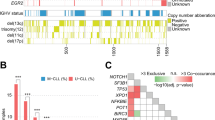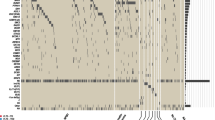Abstract
There is barely any information about the prognostic significance of FLT3 expression and mutational status in cytogenetically distinct subgroups of acute lymphoblastic leukemia (ALL). We analyzed the presence of FLT3-tyrosine kinase domain (TKD) and FLT3-internal tandem duplication (ITD) mutations as well as FLT3 expression levels in 54 newly diagnosed patients with B-ALL (n=49) or T-ALL (n=5). All B/T-ALL samples tested negative for the presence of FLT3-TKD or FLT3-ITD. None of the T-ALL and E2A-PBX1+ B-ALL overexpressed FLT3. In contrast, mainly MLL-AF4+ B-ALL but also ETV6-RUNX1+, BCR-ABL+ or B-ALL displaying normal cytogenetics exhibited significantly higher FLT3 expression levels than normal bone marrow, supporting that aberrantly increased transcription of FLT3, rather than activating FLT3 mutations, contributes to the pathogenesis of these B-ALL. Using the median FLT3 expression as cut-off value we found that high-level FLT3 expression is associated with an extremely poor 1-year overall survival (OS; 0 vs 71%; P=0.002) and disease-free survival (DFS; 0 vs 43%; P=0.03) in MLL-AF4+ B-ALL but not in MLL-germline B-ALL. Cox regression analysis with OS/DFS as end points showed that age>14 years and high-level FLT3 expression were independent prognostic factors when all ALL patients were analyzed together. Importantly, when the MLL-AF4+ B-ALL subgroup was analyzed separately, high-level FLT3 expression was the only independent prognostic factor for OS and treatment outcome. These findings indicate that high FLT3 expression identifies MLL-AF4+ ALL patients at very high risk of treatment failure and poor survival, emphasizing the value of ongoing/future clinical trials for FLT3 inhibitors.
This is a preview of subscription content, access via your institution
Access options
Subscribe to this journal
Receive 12 print issues and online access
$259.00 per year
only $21.58 per issue
Buy this article
- Purchase on Springer Link
- Instant access to full article PDF
Prices may be subject to local taxes which are calculated during checkout


Similar content being viewed by others
References
Bueno C, Montes R, Catalina P, Rodriguez R, Menendez P . Insights into the cellular origin and etiology of the infant pro-B acute lymphoblastic leukemia with MLL-AF4 rearrangement. Leukemia 2011; 25: 400–410.
Chen W, Li Q, Hudson WA, Kumar A, Kirchhof N, Kersey JH . A murine Mll-AF4 knock-in model results in lymphoid and myeloid deregulation and hematologic malignancy. Blood 2006; 108: 669–677.
Krivtsov AV, Feng Z, Lemieux ME, Faber J, Vempati S, Sinha AU et al. H3K79 methylation profiles define murine and human MLL-AF4 leukemias. Cancer Cell 2008; 14: 355–368.
Metzler M, Forster A, Pannell R, Arends MJ, Daser A, Lobato MN et al. A conditional model of MLL-AF4 B-cell tumourigenesis using invertor technology. Oncogene 2006; 25: 3093–3103.
Armstrong SA, Kung AL, Mabon ME, Silverman LB, Stam RW, Den Boer ML et al. Inhibition of FLT3 in MLL. Validation of a therapeutic target identified by gene expression based classification. Cancer Cell 2003; 3: 173–183.
Armstrong SA, Mabon ME, Silverman LB, Li A, Gribben JG, Fox EA et al. FLT3 mutations in childhood acute lymphoblastic leukemia. Blood 2004; 103: 3544–3546.
Ono R, Nakajima H, Ozaki K, Kumagai H, Kawashima T, Taki T et al. Dimerization of MLL fusion proteins and FLT3 activation synergize to induce multiple-lineage leukemogenesis. J Clin Invest 2005; 115: 919–929.
Yamaguchi H, Hanawa H, Uchida N, Inamai M, Sawaguchi K, Mitamura Y et al. Multistep pathogenesis of leukemia via the MLL-AF4 chimeric gene/Flt3 gene tyrosine kinase domain (TKD) mutation-related enhancement of S100A6 expression. Exp Hematol 2009; 37: 701–714.
Gilliland DG, Griffin JD . The roles of FLT3 in hematopoiesis and leukemia. Blood 2002; 100: 1532–1542.
Nakao M, Yokota S, Iwai T, Kaneko H, Horiike S, Kashima K et al. Internal tandem duplication of the flt3 gene found in acute myeloid leukemia. Leukemia 1996; 10: 1911–1918.
Yamamoto Y, Kiyoi H, Nakano Y, Suzuki R, Kodera Y, Miyawaki S et al. Activating mutation of D835 within the activation loop of FLT3 in human hematologic malignancies. Blood 2001; 97: 2434–2439.
Emerenciano M, Menezes J, Vasquez ML, Zalcberg I, Thuler LC, Pombo-de-Oliveira MS . Clinical relevance of FLT3 gene abnormalities in Brazilian patients with infant leukemia. Leuk Lymphoma 2008; 49: 2291–2297.
Taketani T, Taki T, Sugita K, Furuichi Y, Ishii E, Hanada R et al. FLT3 mutations in the activation loop of tyrosine kinase domain are frequently found in infant ALL with MLL rearrangements and pediatric ALL with hyperdiploidy. Blood 2004; 103: 1085–1088.
Xu F, Taki T, Yang HW, Hanada R, Hongo T, Ohnishi H et al. Tandem duplication of the FLT3 gene is found in acute lymphoblastic leukaemia as well as acute myeloid leukaemia but not in myelodysplastic syndrome or juvenile chronic myelogenous leukaemia in children. Brit J Haematol 1999; 105: 155–162.
Stam RW, den Boer ML, Schneider P, Meier M, Beverloo HB, Pieters R . D-HPLC analysis of the entire FLT3 gene in MLL rearranged and hyperdiploid acute lymphoblastic leukemia. Haematologica 2007; 92: 1565–1568.
Stam RW, Schneider P, de Lorenzo P, Valsecchi MG, den Boer ML, Pieters R . Prognostic significance of high-level FLT3 expression in MLL-rearranged infant acute lymphoblastic leukemia. Blood 2007; 110: 2774–2775.
Bardini M, Galbiati M, Lettieri A, Bungaro S, Gorletta TA, Biondi A et al. Implementation of array based whole-genome high-resolution technologies confirms the absence of secondary copy-number alterations in MLL-AF4-positive infant ALL patients. Leukemia 2011; 25: 175–178.
Bardini M, Spinelli R, Bungaro S, Mangano E, Corral L, Cifola I et al. DNA copy-number abnormalities do not occur in infant ALL with t(4;11)/MLL-AF4. Leukemia 2010; 24: 169–176.
Guenther MG, Lawton LN, Rozovskaia T, Frampton GM, Levine SS, Volkert TL et al. Aberrant chromatin at genes encoding stem cell regulators in human mixed-lineage leukemia. Genes Dev 2008; 22: 3403–3408.
Menendez P, Vargas A, Bueno C, Barrena S, Almeida J, De Santiago M et al. Quantitative analysis of bcl-2 expression in normal and leukemic human B-cell differentiation. Leukemia 2004; 18: 491–498.
Gabert J, Beillard E, van der Velden VH, Bi W, Grimwade D, Pallisgaard N et al. Standardization and quality control studies of 'real-time' quantitative reverse transcriptase polymerase chain reaction of fusion gene transcripts for residual disease detection in leukemia - a europe against cancer program. Leukemia 2003; 17: 2318–2357.
Chillon MC, Santamaria C, Garcia-Sanz R, Balanzategui A, Sarasquete ME, Alcoceba M et al. Long FLT3 internal tandem duplications and reduced PML-RARalpha expression at diagnosis characterize a high-risk subgroup of acute promyelocytic leukemia patients. Haematologica 2010; 95: 745–751.
Santamaria CM, Chillon MC, Garcia-Sanz R, Perez C, Caballero MD, Ramos F et al. Molecular stratification model for prognosis in cytogenetically normal acute myeloid leukemia. Blood 2009; 114: 148–152.
Menendez P, Perez-Simon JA, Mateos MV, Caballero MD, Gonzalez M, San-Miguel JF et al. Influence of the different CD34+ and CD34- cell subsets infused on clinical outcome after non-myeloablative allogeneic peripheral blood transplantation from human leucocyte antigen-identical sibling donors. Br J Haematol 2002; 119: 135–143.
Menendez P, Caballero MD, Prosper F, Del Canizo MC, Perez-Simon JA, Mateos MV et al. The composition of leukapheresis products impacts on the hematopoietic recovery after autologous transplantation independently of the mobilization regimen. Transfusion 2002; 42: 1159–1172.
Bursen A, Schwabe K, Ruster B, Henschler R, Ruthardt M, Dingermann T et al. The AF4.MLL fusion protein is capable of inducing ALL in mice without requirement of MLL.AF4. Blood 2010; 115: 3570–3579.
Kumar AR, Yao Q, Li Q, Sam TA, Kersey JH . t(4;11) leukemias display addiction to MLL-AF4 but not to AF4-MLL. Leuk Res 2010; 35: 305–309.
Bueno C, Catalina P, Melen GJ, Montes R, Sanchez L, Ligero G et al. Etoposide induces MLL rearrangements and other chromosomal abnormalities in human embryonic stem cells. Carcinogenesis 2009; 30: 1628–1637.
Bueno C, Montes R, Martin L, Prat I, Hernandez MC, Orfao A et al. NG2 antigen is expressed in CD34+ HPCs and plasmacytoid dendritic cell precursors: is NG2 expression in leukemia dependent on the target cell where leukemogenesis is triggered? Leukemia 2008; 22: 1475–1478.
Bueno C, Montes R, Melen GJ, Ramos-Mejia V, Real PJ, Ayllon V et al. A human ESC model for MLL-AF4 leukemic fusion gene reveals an impaired early hematopoietic-endothelial specification. Cell Res 2012; 22: 986–1002.
Menendez P, Bueno C, Wang L . Human embryonic stem cells: a journey beyond cell replacement therapies. Cytotherapy 2006; 8: 530–541.
Menendez P, Catalina P, Rodriguez R, Melen GJ, Bueno C, Arriero M et al. Bone marrow mesenchymal stem cells from infants with MLL-AF4+ acute leukemia harbor and express the MLL-AF4 fusion gene. J Exp Med 2009; 206: 3131–3141.
Montes R, Ayllon V, Gutierrez-Aranda I, Prat I, Hernandez-Lamas MC, Ponce L et al. Enforced expression of MLL-AF4 fusion in cord blood CD34+ cells enhances the hematopoietic repopulating cell function and clonogenic potential but is not sufficient to initiate leukemia. Blood 2011; 117: 4746–4758.
Stam RW, Schneider P, Hagelstein JA, van der Linden MH, Stumpel DJ, de Menezes RX et al. Gene expression profiling-based dissection of MLL translocated and MLL germline acute lymphoblastic leukemia in infants. Blood 2010; 115: 2835–2844.
Acknowledgements
PM was supported by the Junta de Andalucía/FEDER (P08-CTS-3678), the FIS/FEDER (PI10/00449), the MICINN (Fondo Especial del Estado para Dinamización de la Economía y Empleo-PLE-2009–0111) and the Fundación ‘Spanish Association Against Cancer′/Junta Provincial de Albacete (CI110023). CB was supported by the FIS/FEDER (CP07/0005 and PI11/00119). RM was supported by the FIS/FEDER (CA10/01332). MCC and MG-D were supported by the FIS/FEDER (CA11/00243).
AUTHOR CONTRIBUTIONS
MCC, MTG-C, MG and PM were involved in theconception and design, collection and/or assembly of the data, financial support, data analysis and interpretation and manuscript writing. CEL-J, C R-M, AM, MES, MA, JDG-S, CB, RM, FR, JNR, PG, MR, RG-D and JLF were involved in provision of patient samples, clinical data collection and interpretation, and also in the collection and/or assembly of the data.
Author information
Authors and Affiliations
Corresponding authors
Ethics declarations
Competing interests
The authors declare no conflict of interest.
Additional information
Supplementary Information accompanies the paper on the Leukemia website
Rights and permissions
About this article
Cite this article
Chillón, M., Gómez-Casares, M., López-Jorge, C. et al. Prognostic significance of FLT3 mutational status and expression levels in MLL-AF4+ and MLL-germline acute lymphoblastic leukemia. Leukemia 26, 2360–2366 (2012). https://doi.org/10.1038/leu.2012.161
Received:
Accepted:
Published:
Issue Date:
DOI: https://doi.org/10.1038/leu.2012.161
Keywords
This article is cited by
-
Characterisation of FLT3 alterations in childhood acute lymphoblastic leukaemia
British Journal of Cancer (2024)
-
FLT3 inhibitor lestaurtinib plus chemotherapy for newly diagnosed KMT2A-rearranged infant acute lymphoblastic leukemia: Children’s Oncology Group trial AALL0631
Leukemia (2021)
-
Consolidative allogeneic hematopoietic stem cell transplantation after chimeric antigen receptor T-cell therapy for relapsed/refractory B-cell acute lymphoblastic leukemia: who? When? Why?
Biomarker Research (2020)
-
MLL-Rearranged Acute Lymphoblastic Leukemia
Current Hematologic Malignancy Reports (2020)
-
Molecular processes involved in B cell acute lymphoblastic leukaemia
Cellular and Molecular Life Sciences (2018)



